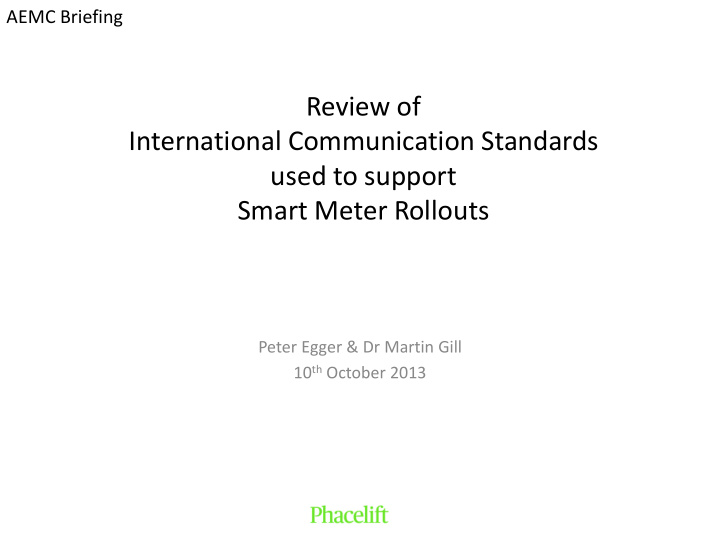



AEMC Briefing Review of International Communication Standards used to support Smart Meter Rollouts Peter Egger & Dr Martin Gill 10 th October 2013
AEMC Workshop Agenda 1. Request for Advice 2. Summary of International Jurisdictions 3. Questions Review of International Comms Standards v01 2
AEMC Workshop Request for Advice • International developments on smart meter communication standards Overview of which standards are commonly used internationally Focus on jurisdictions where retailers and distributors are not the same party • Assess whether the standards are: Well developed? Have the standards converged? • Use in Australia Practical implementation issues for adoption in Australia? Consider who should be the custodian of the standard(s) → Pros and cons Review of International Comms Standards v01 3
AEMC Workshop Summary of the International Rollouts Jurisdiction Meter Protocol HAN Protocol Comms USA (Texas) ANSI C12 Not Specified RF Mesh (Mainly ZigBee) (predominantly) UK DLMS/COSEM ZigBee SEP 1.2 Cellular, RF Mesh, Low Freq RF New Zealand Not Specified Not Specified Unspecified (Cellular popular) Spain DLMS/COSEM Not Specified PRIME PLC All the selected jurisdictions have retail contestability Figures from World Energy Retail Market Rankings 2012 vaasaETT Review of International Comms Standards v01 4
AEMC Workshop Assessment of level of Interoperability Significant effort to carefully While meters use ANSI C12 a define all aspects including protocol translation occurs certification that meters are through the web-portal interchangeable USA (Texas) Spain NZ UK Government recommended Government regulations ensure functionality not included in the use of a common protocol meters (e.g. HAN) hence meters throughout. Detailed functional are Not Interoperable specification suggests meters approach Interchangeable Review of International Comms Standards v01 5
AEMC Workshop Maturity of the Standards • ANSI C12 The USA was an early adopter of protocol standards It has been steadily enhanced and now supports IP connectivity C12.22 defines a physical interface between the meter and comms • DLMS/COSEM Membership DLMS UA DLMS User Association membership has grown steadily The suite of standards is now very comprehensive Certification testing has always been an important feature of the standard • ZigBee ZigBee Alliance has recently approved Smart Energy Profile 2 ZigBee SEP globally adopted in Smart Meter rollouts The development work in the UK highlights that DLMS/COSEM and ZigBee will work together Review of International Comms Standards v01 6
AEMC Workshop Convergence of the Standards • Recent versions of the standards support the Internet Layers Model and can be transmitted over communication networks supporting Internet Protocol (IP) ANSI C12.22 DLMS/COSEM ZigBee SEP 2.x TCP/IP or UDP/IP As defined in Internet Engineering Task Force standards Review of International Comms Standards v01 7
AEMC Workshop Suitability for adoption in Australia • ANSI C12 Predominantly used in the USA Meters not suitable for use in Australia (plug in base) Certification testing is offered • DLMS/COSEM Has already been deployed in Australia Meters typically similar to those used in Australia (bottom connect, etc) Fully supports certification testing of devices • ZigBee SEP SEP 1.0 selected as the HAN standard by Victorian AMI DiUS SEP 2.x selected as the HAN standard by the SMI FS PowerVu IHD Fully supports certification testing of devices Review of International Comms Standards v01 8
AEMC Workshop Companion Specification • End-to-end interoperability starts with the selection of an application protocol • To achieve interoperability ambiguities should be removed e.g. different approaches used to implement same functionality Required minimum set of functionality • Suggests the need to develop a Companion Specification Manage the addition of New Functions Define how these functions are implemented Review of International Comms Standards v01 9
AEMC Workshop Custodian of the “standard” • Australian specifications can refer to International Standards Implies the direct use of International Standards • The custodian will be required to manage (any) Companion Specification • This will require the facilitation of a joint industry working group “It is essential that this Companion Specification should be developed by a joint effort of manufacturers and utilities and other stakeholders ” – OPEN Meter Project Review of International Comms Standards v01 10
AEMC Workshop Suggested Options for the Custodian Association Pros Cons Standards Australia Companion Specification is not a “standard” Cost to develop the “standard” Limited knowledge of smart metering Australian Energy Market Good knowledge of May not be a suitable party (*) Operator (AEMO) metering and the NEM National Measurement Knowledge of metering and Institute (NMI) certification testing Used to working in highly technical areas (*) Were AEMO selected to provide meter access (via an enhanced B2B Gateway) they would no longer be a neutral party Review of International Comms Standards v01 11
AEMC Workshop The advantage of selecting common Applications Accredited Parties can interact with any meter Review of International Comms Standards v01 12
AEMC Workshop International SMI Rollouts Texas Protocol translation in web-portal controls Accredited Party access to meters UK Common protocol with contestable meter provision (allows Advanced Functions). Direct Suspect Data Services Provider may limit Access Spectrum Access direct access to meters Advanced Spain Functions Interchangeable Meters but tight standards likely to limit Advanced Functions Regulated Functions New Zealand Closed No evidence of Smart Meter functionality being made available to Accredited Parties Not Interoperable Protocol Translation Common Protocol Interchangeable Interoperability Spectrum Review of International Comms Standards v01 13
AEMC Workshop Questions Review of International Comms Standards v01 14
AEMC Workshop Appendix Review of International Comms Standards v01 15
AEMC Workshop Appendix Assessment of level of Interoperability USA (Texas) Review of International Comms Standards v01 16
AEMC Workshop Appendix Assessment of level of Interoperability UK Review of International Comms Standards v01 17
AEMC Workshop Appendix Assessment of level of Interoperability NZ Review of International Comms Standards v01 18
AEMC Workshop Appendix Assessment of level of Interoperability Spain Review of International Comms Standards v01 19
Recommend
More recommend